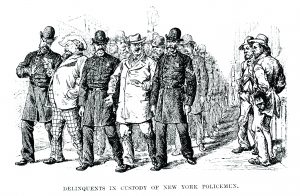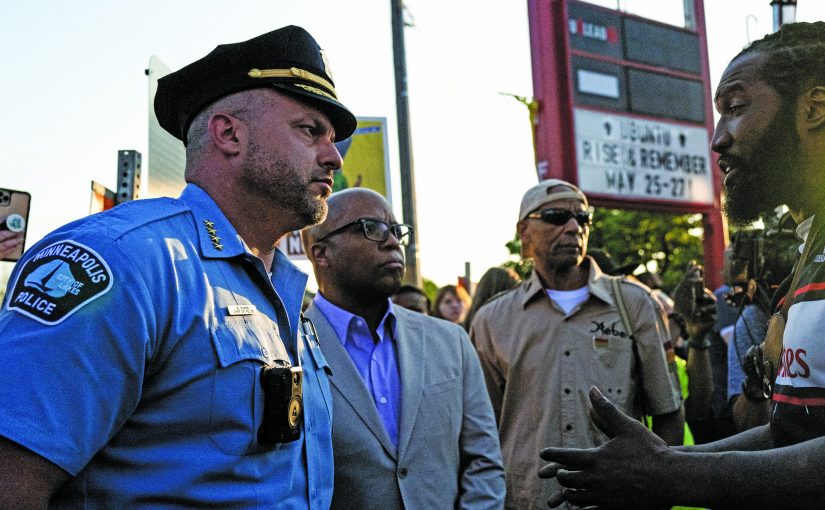Three officers watched as their training officer that day effected an arrest. They watched as the senior officer on the scene, for nine and half minutes, applied 92 lbs. of weight onto the neck of a handcuffed suspect. And, as bystanders’ cameras rolled, the world watched the murder of George Floyd.
In almost all cases of excessive use of force, most people only get to see pictures of the final result—a brutalized suspect or a dead body. This often leaves people to grapple with games of he-said/she-said as the public, courts, and police try to piece together what actually happened. The case of George Floyd is significant because, for the first time, a whole scene played out before people’s eyes. There was little to no room for disagreement or debate.
There is a difference between defending the profession and defending every officer accused of committing a heinous crime. And, in too many cases, many chiefs, sheriffs, and politicians get the two confused. After George Floyd’s death, the usual rush of policing agencies to defend their own “until the investigation is completed” fell silent. Amid the silence, the black community felt both angry and vindicated.
Policing agencies with excessive force incidents have had to take a hard look at themselves—was it the officer or was it the agency culture? After George Floyd, however, the entire profession has to take a hard look at itself and ask the same hard questions. Is it really only a few bad apples or is there something wrong with the culture of policing in the United States?
Since George Floyd, the profession of policing has struggled. The constant bashings across digital platforms have taken their toll. Highly regarded officers have handed in their badges, with many reporting their kids getting bullied at school because their mom or dad is a cop. Recruiting numbers have plummeted as a large percentage of an entire generation struggles with the idea of joining the profession. And the United States as a whole still grapples with the question, what can be done to stop this from happening again? Or more to the point, what is the reason police exist?
Asking why the police exist is not the same as calling to disband the police. It is a legitimate question of purpose. What is the purpose of the police? “To enforce the law,” many will say. “To prevent crime,” others will offer. A few may recite whatever slogan is stamped on the door of their patrol vehicle— “to protect and serve” or some variation. Words that sound right but are not used to guide training, recognition, rewards, or tactics.
These vague answers reveal a huge gaping hole—an entire profession without a clear and unified sense of identity or higher purpose beyond what they do. Peeling the onion further reveals a profession that lacks the availability or, in too many cases, even the desire to include any substantive modern leadership training. Whereas institutions like corporations and the U.S. military constantly update and adapt their leadership training to meet the times, the kind of leadership theories still embraced in policing are now about 20–30 years out of date.
The Real Problem
The profession of policing is at a crossroads. Critical incidents and controversial actions by officers fill the news cycle on a regular basis. Media and social media narratives about policing dominate the airwaves and real estate on smartphone screens while Hollywood scripts glorify excessive force and ego and make a mockery of the justice system. Cultural narratives focus on “the police” when, in reality, there are more than 18,000 agencies across the United States, each with distinct approaches to policing in the communities they serve, all judged against a perceived nationwide monolithic police force.
It’s been said, “You can have a culture by design or by default.” Too many police agencies currently have a culture by default. Like a company or even a family, a culture is a living, breathing part of the organization, and it is up to the leaders of any organization to define the culture based on values and do the constant work of maintaining that culture. This includes hiring; firing; training; recognition; rewarding; and, yes, coaching officers in how to lead as they make their way up the ranks.
But, first, the profession and its leaders need to sit down and understand where policing comes from and where the profession needs to go.
The History of U.S. Policing
U.S. citizens know their history—at least the basics. Most know the Declaration of Independence was signed on July 4, 1776, and declared the United States’ independence from Great Britain. Most know the names of some of the country’s founding fathers, including the first U.S. president, George Washington. It is a connection to history that helps people of any nation have a sense of identity, but this connection also conveys a responsibility to build a future that honors that history and those who made sacrifices to achieve that history. The U.S. Marine Corps does the same. It makes sure Marines know their history for the same reason—it makes a stronger Corps. How many officers and deputies know the history of their own profession?
The history of the policing profession in the United States is complex and messy. Starting before the American Revolution, law enforcement was mostly a loosely organized night watch. It wasn’t very effective, and many on the night watch were often drunk or asleep while on the job. After the American Revolution, the profession continued to evolve. In slave-owning states, where slavery was central to the financial economy of the state, the profession became more organized with a primary focus on catching escaped slaves. These “police departments” operated with impunity to serve as a deterrent for any other slaves who would dare try to escape. In non-slave owning states, history followed a different path—evening watchmen in cities were looking for law violators and were heavily influenced by England.
In the early stages of development in both England and colonial America, citizens were responsible for law enforcement in their communities. In England, the responsibility of enforcing laws shifted from individual citizen volunteers to groups of men living within the community. A similar structure also existed in northern colonial America in which constables, sheriffs, and citizen-based watch groups were responsible for policing within the colonies.
In 1829, Sir Robert Peel introduced a Bill for Improving the Police in and Near the Metropolis (Metropolitan Police Act) to Parliament with the goal of creating a police force to manage the social conflict and civil unrest resulting from the rapid and quick urbanization and industrialization taking place within London. Peel’s intentional efforts resulted in the creation of the London Metropolitan Police. Sir Robert Peel played an integral role in the creation and development of London’s police department, as well as several basic principles that would later guide the formation of police departments in the United States.
Starting in Boston, Massachusetts, in 1838, the volunteer night watch was done away with and replaced with a professional group of police officers whose culture was built by design based on the theories of Sir Robert Peel.¹
Then, in 1861, the U.S. Civil War broke out and the evolution of policing in the United States ostensibly came to a halt. After the Civil War ended on April 9, 1865, it would be expected that, with slavery abolished, the Peelian principles of policing would spread across the entire United States. However, not even a week after the Civil War had ended, Abraham Lincoln, a Republican, was assassinated, and Vice President Andrew Johnson, a Democrat, stepped into the office of president. Johnson was a Southern sympathizer and chose to look the other way as many of the harsh tactics of the former slave catchers became part of police culture in former slave-owning states. As time progressed, U.S. policing evolved in a somewhat haphazard way.

This history leads to where U.S. policing is today—a profession whose culture has largely been defined by default rather than by design. In time, this pieced-together Frankenstein model has left many agencies in a predicament, which has led to a profession unable to see the real, cultural challenges it has, let alone take accountability for what happens in agencies whose leaders ignore or neglect leadership training and effective culture building.
But this is not a story of woe. This is an amazing opportunity. It is today’s chiefs and sheriffs who get to plant a stake in the ground and declare their vision for the profession and the values around which they want to build it.
Purpose of Policing
Knowing why someone does something—having a true sense of purpose that’s bigger than the work one does—truly matters. It gives meaning to the work and one’s life. It injects a sense of nobility into the work being done. And it impacts the way people think about and perform their duties. Articulating a sense of purpose is something a huge number of organizations across many industries in the United States are attempting and an even greater number of employees are demanding. It’s time for the profession of policing to do the same.
Too many police officers and deputies say that they work in “law enforcement” and that their purpose is to protect and serve the populations for which they work (or words to that effect). However, “enforcing the law” is only one function of the profession and does not capture the true purpose of the profession. Words like “protect and serve,” at best, offer vague guidance of how an officer should behave, but more commonly are ignored taglines that exist mainly to decorate the sides of patrol cars. The profession of policing needs a sense of purpose that inspires: Police exist to protect the vulnerable from harm.

This simple change in language matters. In addition to restoring nobility to the profession, a clear statement of purpose helps officers and deputies to see their work as bigger than just enforcing laws. For example, if an organization tells a new recruit officer who just graduated from the academy that the purpose of their job is “law enforcement,” then they will go out looking to enforce the law. However, if that same policing organization tells a new officer that their job is to protect the vulnerable from harm, they will set out to be a protector, not an enforcer (which includes protecting people from those who would break the law).
Mission of Police
Those who are dedicated to protecting the vulnerable from harm must know how to do that. Beyond the hard skills they must learn to do their jobs, officers must understand there is also a moral code to guide them along the way:
Preserve life.
Preserve peace.
Preserve property.
There is a hierarchy to this code. Preserving life is the highest priority of the profession. A police officer may destroy property to protect the peace or may disrupt the peace to protect a life. Police officers may not, however, take a life to protect property.
Simply stating such a hierarchy will cause some to challenge it. The reality of policing is complicated, and decisions are made under pressure and in “gray” spaces. Having a moral ideal to constantly strive toward makes better officers, deputies, and troopers and serves to advance the profession. If a police agency teaches new officers that their ultimate priority is to protect life, it will change the way in which they see themselves and the public, and it will influence how they perform their jobs for the better.
Policing Culture

For years, the private sector and military have placed a focus on organizational culture. In fact, some organizations have now created official roles that focus on organizational culture with titles like “chief of culture.” There are many examples of healthy cultures in these industries in which organizations focus on purpose and value their people. Those organizations tend to have happier team members, lower turnover rates, and successful outcomes.
For example, WD-40 created a “tribal” culture in which each team member is considered a leader and a developer of people, whether themselves or others. Each person is also considered an important contributor to the business. The company firmly believes its people are what makes them successful. In the more than 20 years, WD-40 has built a learning culture on a foundation of values while also increasing its market capital from $300 million to approximately $2.5 billion.²
At many technology-driven companies, such as Airbnb, software engineers are treated as valued team members from day one. That is because engineers are critical to the success of the company.
Contrast the above examples to the cultures that exist in many policing agencies throughout the United States. The top-down directive leadership style popularized in the 1980s and 1990s still exists in too many U.S. police departments.
This type of leadership in police organizations has not created the type of culture or workplace environment that is consistent with successful outcomes for building internal and external trust.
Police leaders who turn a blind eye, or worse yet, embrace practices such as hazing new police recruits or placing too much of a focus on traditional metrics such as the number of tickets and arrests are not building a culture that will advance the profession.
Leaders in the policing profession need to ensure new recruits are treated as valued members of the team from day one. Not only is it the right thing to do, but it also sends the message that people are just as critical to the success of communities as software engineers are to the success of technology companies.
One-by-One Policing
The policing profession needs to evolve. From the military to health care and corporations to entrepreneurial ventures, organizations across the United States are experimenting with and embracing new ideas about leadership and culture. Law enforcement, meanwhile, is probably 20 years behind. The profession of policing must adapt and advance to meet the challenges of a modern world.
One approach that has proven to be successful for police organizations is called One-By-One Policing. This model encompasses three main tenets:
-
- Serve people as individuals—Shift from the idea of serving a group of people or serving the community to a focus on serving individuals, one person at a time.
- Create safe and secure environments—Build a circle of safety in order to create a work environment that is both physically and psychologically safe for all team members.
- Help people thrive—When individuals feel seen, heard, and understood, the organizations and communities in which they belong are more likely to be seen, heard, and understood.
Some benefits of One-By-One Policing include
-
- increased trust within the organization and the community,
- a culture that favors de-escalation,
- stronger resilience for individuals and the organization,
- higher quality policing overall, and
- strong hiring and retention results.
It is essential police leaders invest as much time and energy into culture as they do for training, equipment, and technology. Providing police personnel with top-notch training, the best equipment, and state-of-the-art technology means nothing without a healthy culture that pulls it all together. In fact, culture is so important, all police chiefs and sheriffs should also consider themselves the “chief of culture.”
Conclusion
There are multiple leaders in policing, of all political viewpoints and from all parts of the United States, who are setting an example of what the profession could look like. Their agencies tend to be higher performing and enjoy lower crime rates, high morale, strong retention rates, better relationships with the community, and a lower propensity for scandal or charges of abuse. They are taking risks to do things differently than how things were done when the leaders were young in their careers. They are challenging the status quo and serving as examples of what modern policing can look like. The profession must find them and learn from them.
The murder of George Floyd and the incidents that have followed over the past few years must serve as a clarion call to all police personnel. It is no longer feasible to sit idly by and allow the profession to continue to meander down a path and blindly defend those who sully the uniform. This is an opportunity to stand together and declare what policing in the United States can look like now and for generations to come.
Evolving agencies from the inside-out is what’s needed to change the profession. Leaders cannot make positive changes within their own community until those in their span of care feel appreciated and valued and are treated with dignity and respect. The profession of policing has no choice, and every police leader must work to ensure their agency has a culture by design. Failure to do so will only exaggerate and exacerbate all the pressures and challenges that exist now. If this occurs, policing has failed as a profession, and it cannot afford to fail. Success is owed to those the police are sworn to protect. 🛡
Notes:
¹Gary Potter, “The History of Policing in the United States, Part 1,” EKU Online (blog), June 25, 2013.
²WD-40 Company, “Our Tribe”; Susan Fowler, “WD-40’s Secret Formula Might Surprise You, Garry Ridge Says,” SmartBrief, May 24, 2023.
³Mike Curtis, “Engineering Culture at Airbnb,” The Airbnb Tech Blog, June 5, 2014.
Please cite as
Jack Cauley et al., “Transforming Policing Culture,” Police Chief 90, no.` 9 (September 2023): 40–45.



